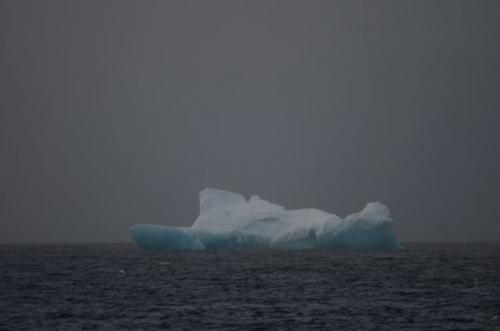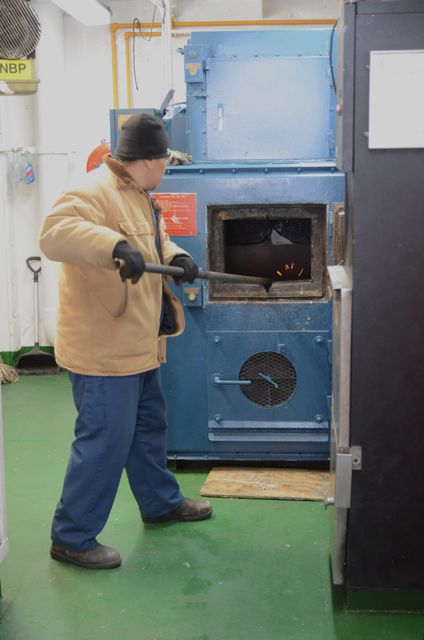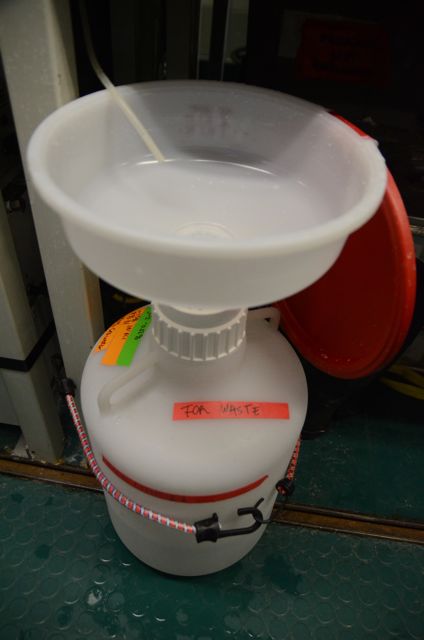I am enjoying so much working on this journal. Topics arrive like magic! I go to bed trying to figure out a topic for the next day, but sometimes when I wake up, something happens that redirects my interest. This is one of those days.
The topic came courtesy of a girl who had her dad write a question in our forum (the 'Ask the Team' tab). As I began to answer the question, I thought that a lot of people might be interested in this topic and decided to move it to the journal and make it more visible. The question is,
' What are the main polluting substances for the oceans and where do they come from, particularly in the Southern Seas? I only managed to say that many metals (Hg, Mg, etc), and increasingly CO2 levels, but can you bring the light up to our ignorance?'
The question is good, and the answer is pretty close. The words of a zoology professor I had as an undergrad resonate here 'All and nothing can be a poison(pollutants), it all depends on its concentration'. You will read here that the waters around Antarctica are not polluted, and that we are trying our best to leave them like that. I chose a picture of a recently sighted iceberg to illustrate the pristine waters around here,

In the global scale, most pollutants that arrive to the oceans arrive from the atmosphere, like CO2 and mercury (Hg on his answer). At coastal scale, rivers and runoff can have a very big impact depending on what they dump. Here is another way of viewing it:
- Pollution has a bigger impact in coastal areas where rivers dump all sorts of things. Our knowledge on this topic here on the ship is very biased to the US. I have heard that rivers in different countries are allowed to dump different chemicals, but I do not know more than that.
One example of coastal pollution is a large area with very low levels of dissolved oxygen on the Gulf of Mexico due to fertilizers arriving to the ocean though rivers (Mississippi, mainly) and over production of plankton that ends up using most of the oxygen. The result, an anoxic (low oxygen) area with little life.
Pharmaceutical drugs: believe it or not, all those medications that people flush in the toilet when they do not need them or that have expired are having an impact on organisms in coastal waters. It is important to properly dispose unused medications. There are places in the US that collect and dispose of them. If you live in the US, check with your town or city government for more information.
There is pollution in areas close to the coast that do not involve rivers or runoff. An example is oil spills in production areas. Massive oils spills like the one in the Gulf of Mexico last year called a lot of attention, but there are many low level spills we do not hear about. One of our experts on the ship says that these spills have short time impact (on the scheme of things, decades is short time for these processes), since there are naturally occurring bacteria that take care of the spills in the long run. For our everyday lives and the lives of the organisms that live in spill areas, these are important pollutants.
Plastics. This is the biggest large scale pollutant that does not arrive by the atmosphere. There are large areas in some parts of the oceans where the currents collect a lot of floating debris (they correspond to the center of the subtropical gyres). As a result, there are very large areas with tons of plastic that range from very large chunks to very tiny pieces that are floating in a thick layer below the surface. The most famous is the very large Pacific patch, but there is also one in the Atlantic Ocean. There is a strong movement, again in the US, to curtail the use of plastic bags. I encourage everybody to use the least amount of plastics as possible to prevent our plastic patches from increasing.
Ocean acidification: I would consider ocean acidification a consequence of CO2 pollution from the atmosphere. I find the chemistry that explains the CO2 flow to the oceans very complicated, but the net effect is that the ocean is becoming more acidic.
The problem with ocean acidification is that acids dissolve certain minerals like calcium carbonate. You can see this by adding a few drops of vinegar on a teaspoon of baking powder, which has calcium bicarbonate. There are many planktonic organisms that have calcium carbonate skeletons, as well as bigger organisms, like seashells and corals. We do not know yet if they will be able to adapt to a new acidic ocean. We are measuring pH levels (acidity) on these waters as part of the effort to study ocean acidification
- Metals: We have heard that sea animals on the high end of the food chain contain lots of mercury. Our expert on metals here on the ship had this to say:
'Man has increased the delivery of mercury to the oceans by about a factor of 3-4, so that if nothing else had changed, fish would have 3-4 times more mercury than before. Top predators (the ones that eat fish) will accumulate the most mercury, and would have always had the highest mercury levels. But man's increase in mercury delivery makes the problem even worse.
You mentioned Magnesium (Mg). Magnesium is one of the major ions in seawater, and contributes to the salinity we measure. It is not a pollutant. There is no evidence that any other heavy metal, except lead (Pb), has increased in the vast majority of the ocean. Pb has been decreasing now since we took Pb out of gasoline, but even at it's highest point, it was never at a level to harm the organisms. In restricted bays, or where many naval ships are based, we see higher levels of copper (Cu) and tin (Sn) since that is used in the paint of the ships hulls to keep organisms from colonizing the hulls. Hull paint with tin has been disallowed for many years, but I believe our Navy still uses it because it works better than paint with copper in it.'
People I talked with on the boat believe that Antarctic waters are very clean. There is not much human activity nearby. The only pollutants must come from the air. A big objective of this cruise is to quantify the amount of CO2 that goes into these waters as a result of the increase in atmospheric CO2.I recommend yo look at a nice website that explains in more detail the CO2 fluxes:
http://carboncycle.aos.wisc.edu/
About the waters around Antarctica, the human activities taking place around Antarctica are in ships and research stations. The very strict international rules that govern Antarctic waters (south of the Antarctic CircumpolarLocated or found within the Earth’s polar regions. Current, ACC) and the continent stipulate that nothing can be dumped in these waters. I wrote a journal entry about how McMurdo Station complies with these rules (February 17), perhaps it is time to check how we do it on the ship.
We burn all of our trash in an incinerator aboard the N.B. Palmer, except for materials that are hazardous to burn, like the chemicals that we use in the laboratory, and others that are explosive, like batteries, halogen lightbulbs and sprays. We do leave a smoke trail behind the boat, not only form the incinerator but from the diesel engines that propel us through the ever changing ocean surface.

We have a water treatment plant that crunches all waste and then zaps it with electricity before releasing the waste to the ocean. The process kills all living organisms without the use of chemicals. The process is stopped 30 minutes before we get to a sampling station.
We do use some chemicals in our labs that are collected for their later disposal when we are done with them. We empty the small containers, like the one below, into 50 gallon metal drums.

The drums will make their way at the end of the cruise to Palmer Station on the Antarctic Peninsula. They will be stored with the station's chemical waste and waste from other cruises. Every two years a large shipment is sent to the US from Palmer Station for its proper recycling or disposal.
It is a human reality to dispose of our waste. The best we can do is to limit the amount of waste we as individuals generate with our every day choices, reuse and recycle. We all end up juggling our trash like Sam on the Palmer.

Estoy disfrutando mucho el escribir este diario. Los temas me llegan como por magia. Me voy a la cama cada noche pensando en el tema para el día siguiente, pero hay días en los que algo ocurre que cambia mi interés. Hoy es uno de esos días.
El tema me llegó cortesía de una niña que le pidió a su padre nos escribiera mediante el foro (la lengüeta del 'Ask the Team'). Al escribir la contestación, pensé que mucha gente estaría interesada en el tema, por lo que decidí mover la respuesta al diario para hacerlo más visible. La pregunta es:
'¿Cuales son los contaminantes principales en los océanos y de dónde vienen, particularmente en los mares del Sur? Yo sólo pude decirle que algunos metales (hg, Mg, etc.), y el aumento en los niveles de CO2, pero ¿podría iluminar nuestra ignorancia?'
La pregunta es buena, y la respuesta bastante acertada. Me llegan las palabras de un maestro de zoología que tuve en la licenciatura que dijo 'todo y nada es veneno (contaminante), todo depende de su concentración'. Vas a leer aquí que las aguas de los mares del Sur no están contaminadas, y que estamos haciendo todo lo posible para que así permanezcan. Escogí la foto de un témpano de hielo reciente para ilustrar lo limpias que están estas aguas.

A escala global, la mayoría de los contaminantes que llegan al mar lo hace por la atmósfera, como el CO2 y el mercurio (Hg, en su respuesta). A escala costera, los ríos y el escurrimiento pueden tener un impacto muy grande dependiendo de lo que acarreen. Aquí otra forma de ver esto:
- La contaminación tiene un impacto mayor en las zonas costeras donde los ríos vierten en el mar toda clase de porquerías. El conocimiento colectivo del barco se centra en los Estado Unidos. Se que diferentes países tienen diferentes límites de contaminantes para los ríos, pero no tenemos más detalles sobre esto.
Un ejemplo de contaminación costera es una gran área en el Golfo de México con muy bajos niveles de oxígeno. Esto se debe a que los ríos, principalmente el Mississippi, vierten grandes cantidades de fertilizantes. Los fertilizantes generan gran producción de pláncton que acaba por consumir el oxígeno. El resultado es esta gran area anóxica (sin oxígeno) con pocos organismos vivos.
Fármacos: aunque parezca increíble, todos los medicamentos que la gente tira por el escusado porque ya no los usa o porque están caducos están teniendo grandes efectos en los organismos costeros. Es muy importante el deshacerse adecuadamente de los medicamentos. En los Estados Unidos hay sitios que reciben medicamentos para su procesado. Si vives en los EU contacta a tu gobierno local para saber donde se encuentran estos sitios.
Se puede tener contaminación en áreas cercanas a la costa sin involucrar los ríos. Los derrames petroleros son un buen ejemplo. Derrames masivos como el ocurrido en el Golfo de México el año pasado llaman mucho la atención de la gente, pero hay infinidad de derrames pequeños en éstas zonas de los que pocos saben. Uno de nuestros expertos del barco afirma que los impactos de derrames tienen una escala de tiempo muy corta (de décadas, lo cuál es corto para el planeta, pero no para nosotros). Afirma que hay bacterias que se alimentan de los derrames y que acaban por limpiar las zonas. Estas contaminación es muy importante para nuestras cortas vidas y la de los organismos cercanos a los derrames.
Plásticos. Este es el contaminante global más importante en escala global que no llega por la atmósfera. Hay grandes áreas en partes de los océanos en los que las corrientes agrupan la basura flotante (el centro de los giros subtropicales). Como resultado, hay grandes áreas con toneladas de plástico, cuyo tamaño va de grandes pedazos a diminutos pedacines, flotando en una capa gruesa incluso debajo de la superficie. El más famoso es el gran parche del Pacífico, pero hay otro en el Atlántico. Hay un movimiento voluntario fuerte en lo sEU para restringir el uso de bolsas de plástico para evitar este tipo de contaminación. Yo te invito a que limites el uso llevando al mercado bolsas reusables y comprando productos con menos plástico cuando se pueda.
Acidificación del océano: yo considero la acidificación del océano un problema de contaminación ya que se debe al aumento de CO2 atmosférico. Los procesos químicos para entender el flujo del CO2 me parecen un poco complicados, el resultado neto es que los océanos se vuelven más ácidos.
El problema con la acidificación del océano es que los ácidos disuelven ciertos minerales como el carbonato de calcio. Para entender el efecto basta poner unas gotas de vinagre en polvos de hornear, que son bicarbonato de calcio. Hay muchos organismos del plancton oceánico con esqueletos de carbonato de calcio, así como organismos más grandes como las almejas y los corales. Aún no sabemos si lograrán adaptarse estas nuevas condiciones. En este crucero stamos midiendo el pH del agua de mar para estudiar más este fenómeno.
- Metales: Hemos escuchado que los animales marinos al final de la cadena alimenticia tienen mercurio. Nuestro experto abordo en metales nos dice lo siguiente:
'El hombre a aumentado la cantidad de mercurio en los océanos en un factor de 3-4 veces los niveles naturales. Los grandes depredadores que comen peces siempre acumulan la mayor cantidad de mercurio, pero este problema se magnifica cuando agregamos más mercurio en el mar
Mencionas Magnesio (Mg). Magnesio es uno de los iones más abundantes en el agua marina y contribuye a la salinidad que medimos. No es un contaminante. No hay evidencias que otro metal pesado, excepto el plomo (Pb), haya aumentado en loos océanos a nivel global. La cantidad de plomo en el mar ha ido declinando desde que le quitamos el plomo a las gasolinas. Los niveles máximos alcanzados no llegaron a da˜ãr a los organismos. En bahías y zonas costeras, o donde se tienen grande s flotas de buques, se registran grandes altos niveles de cobre (Cu) y Sn (se me escapó el nombre de 'Tin' en español, mil disculpas) ya que se utilizan en pinturas de barco pra evira el crecimiento de organismos en éstos. En EU no se permite el uso de Sn en pinturas, pero me parece que la armada de EU todavía la usa por ser más efectiva.'
La gente con la que he hablado en el barco cree que las aguas alrededor de la Antártida están muy limpias. No hay mucha actividad humana por acá. kLos únicos contaminantes que llegan lo hacen por la atmósfera. Uno de los objetivos principales de este crucero es el medir la cantidad de dióxido de carbono que pasa de la atmósfera al mar. Si te interesa aprender más sobre el tema de los flujos de dióxido de carbono te recomiendo una página web muy buena y sencilla que ayudé a traducir:
http://carboncycle2.aos.wisc.edu/
Sobre el nivel de contaminación de las aguas del Mar del Sur, la única actividad humana por acá se desarrolla en estaciones de investigación y en embarcaciones. Las regulaciones internacionales que gobiernan estas aguas (al sur de la corriente circumpolar Antártica) son muy estrictas, y no permiten que se tire absolutamente nada. Escribí en el diario del 17 de febrero como la estación McMurdo cumple con estos tratados, quizá es hora de ver como le hacemos en el barco.
Acá quemamos toda la basura en un incinerador, excepto por materiales que son peligrosos al quemarse como baterías, latas de spray, focos de halógeno y desechos químicos de los laboratorios. Si dejamos una nube de humo que sale del incinerador y de los motores dísel que nos permiten deslizarnos sobre la siempre cambiante superficie del mar.

TEl buque tiene una planta de tratamiento de agua negras en la que los desechos se licúan y se pasan por una corriente eléctrica para matar cualquier organismo sin el uso de químicos, antes de soltarse al mar. El proceso se para media hora antes de llegar a estación.
Usamos algunos químicos en los laboratorios que son almacenados para su posterior procesado. Se guardan en pequeños contenedores, como el de la fot, y luego se vierten en barriles metálicos de 50 galones.

Los barriles serán almacenados en la Estación Palmer en la Península Antárctica junto con los desechos químicos de la estación y otros cruceros. Cada dos años se envían estos barriles a EU para su procesado y desecho.
Es una realidad humana el lidiar con los desechos que producimos. Lo mejor que podemos hacer es limitar nuestros desechos, resusar y reciclar lo más que se puede. Al final acabamos malabareando nuestros desechos como Sam en el barco.


Comments